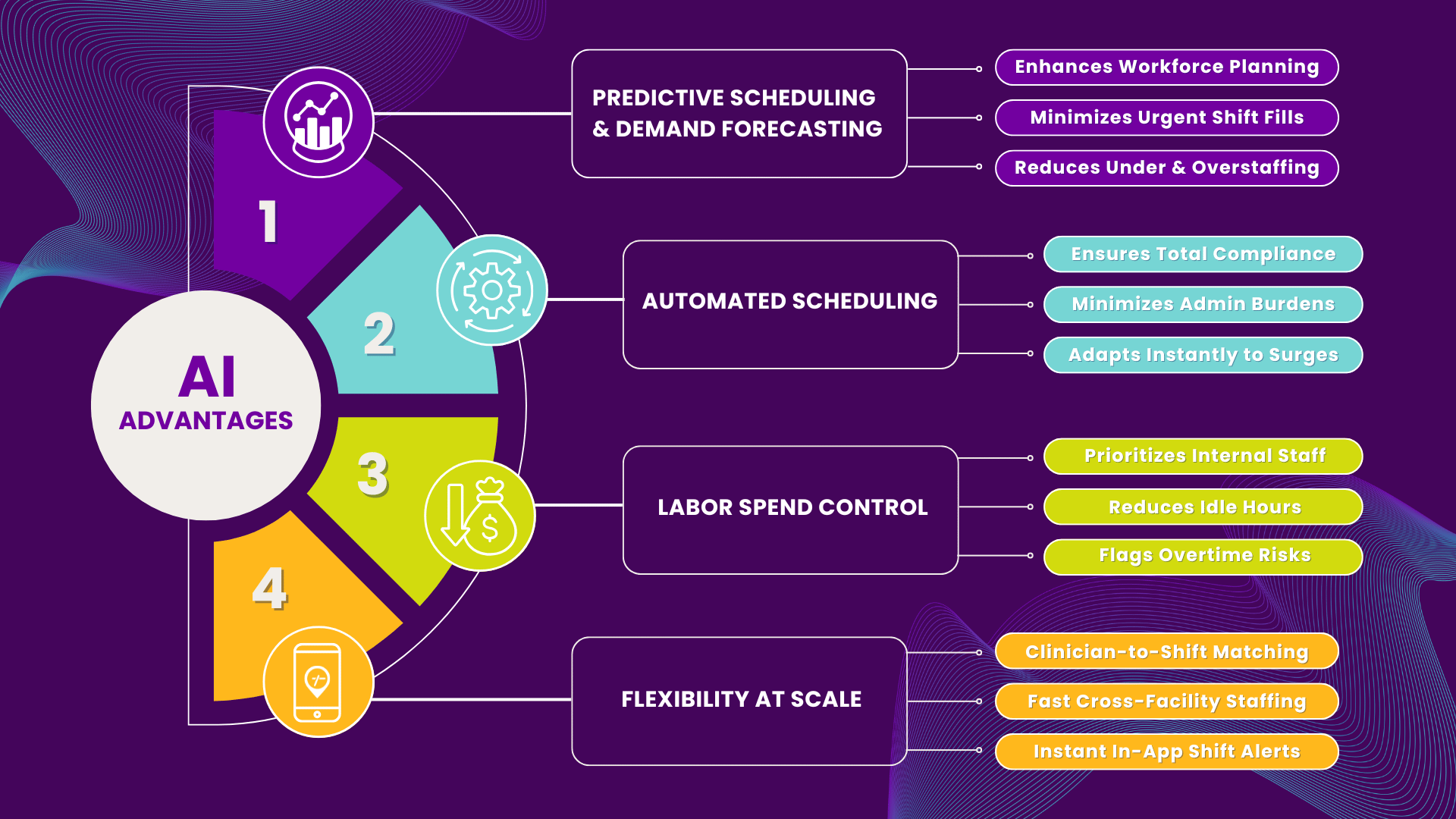How AI Is Taking Over Healthcare Workforce Management

The nursing workforce is stretched thin—shortages, rising demand, and tighter budgets are pushing hospitals to the brink. Leaders must deliver quality care with fewer resources. The good news? AI in healthcare workforce management is already changing the game. Here’s how it’s helping hospitals gain a strategic edge and reduce risk.
4 Advantages of AI Workforce Management in Healthcare
Healthcare staffing isn't just about filling shifts these days. It's about doing so efficiently, accurately, and sustainably. With growing administrative pressure, tighter budgets, and a persistent nursing shortage, AI can modernize how hospitals and health systems manage their workforce.
1. Predictive Scheduling and Demand Forecasting
One of the most powerful applications of AI is its ability to analyze massive datasets, including historical staffing patterns, seasonal patient trends, and real-time census volumes. AI models use this information to accurately forecast staffing needs days or even weeks in advance, enabling:
Proactive workforce planning.
Fewer last-minute scrambles to fill shifts.
Reduction in understaffing (risking care) and overstaffing (wasting resources)
The Bottom Line: Predictive scheduling in healthcare helps clinical leaders align their teams with patient demand before it becomes a crisis.
2. Automated Nurse Scheduling
Manual scheduling is time-consuming and often leads to inefficiencies or dissatisfaction among nursing staff. AI-powered scheduling platforms can automatically generate shift rosters that:
Balance legal, union, and clinical requirements.
Account for individual preferences, certifications, and fatigue levels.
Adapt in real time to callouts, census surges, or unit-level changes.
The Bottom Line: AI in healthcare workforce management simplifies scheduling, creating fair, efficient, and adaptable shift plans that keep nurses engaged and operations running smoothly.
3. Cost Efficiency and Labor Spend Control
Workforce inefficiencies are among the biggest drivers of uncontrolled labor costs in healthcare. AI helps curb these costs and establish healthcare workforce optimization by:
Prioritizing nurse float pools and per diem staff over costly agency usage.
Flagging overtime before it happens.
Streamlining scheduling to reduce idle hours.
The Bottom Line: By matching the right staff to the right shift at the right time, AI enables clinical leaders to optimize labor spending without compromising care quality.
4. Workforce Flexibility at Scale
Today’s multigenerational nursing workforce is dynamic, spanning full-time, part-time, PRN, and per diem clinicians with unique needs. Managing this complexity manually is nearly impossible. AI in healthcare workforce management makes it seamless by enabling:
Real-time matching of available clinicians to open shifts.
Instant communication via mobile or scheduling apps.
Cross-facility or cross-unit staffing at the push of a button.
The Bottom Line: Scheduling flexibility improves coverage, minimizes burnout, and ensures your facilities remain fully staffed, even during periods of high demand or limited availability.

4 Ways AI Mitigates Risk in Healthcare Workforce Management
While AI drives strategic value, it also serves as a critical safeguard against the operational and compliance risks that threaten hospitals and health systems. By identifying early warning signs, automating compliance checks, and enabling rapid response to disruptions, AI helps leaders prevent staffing issues before they happen.
1. Reduces Burnout and Turnover
Burnout is one of the top reasons nurses leave the profession. AI in healthcare workforce management helps prevent it by:
Automating schedules that enforce adequate rest.
Rotating high-stress assignments more fairly.
Flagging clinicians at risk of overwork for early intervention.
The Bottom Line: Aligning scheduling decisions with workforce well-being can improve nurse satisfaction and retention within your organization.
2. Ensures Compliance and Credentialing
Credentialing errors can lead to fines, patient safety risks, and reputational damage. AI-powered workforce tools reduce this risk by:
Tracking and verifying nurse licenses, certifications, and expiration dates.
Enforcing compliance with labor laws and scheduling rules.
Blocking non-compliant staff from being scheduled.
The Bottom Line: AI protects your organization by scheduling only qualified, compliant nurses, minimizing legal risk, safeguarding patients, and preserving your reputation.
3. Improves Continuity of Care
When shifts are filled last-minute or by unqualified nurses, continuity of care suffers. AI in healthcare workforce management helps ensure:
Clinicians are matched to each shift based on skills, experience, and unit familiarity.
Staffing levels remain stable, even during surges or callouts.
Patients receive consistent, high-quality care from familiar nurses.
The Bottom Line: AI supports consistent, high-quality care by matching the right clinicians to the right shifts and maintaining stable staffing across every unit in your facility.
4. Enhances Response to Disruptions
From flu season to natural disasters to global pandemics, healthcare organizations must be ready to adapt fast. AI in healthcare workforce management enables agile crisis response by:
Rapidly reallocating staff based on real-time availability and patient needs.
Scaling flexible labor models up or down depending on system strain.
Keeping leaders informed with live data to make fast, informed decisions.
The Bottom Line: In high-pressure situations, AI acts like a control tower, guiding resource allocation with clarity and speed across your organization.
AI Is the Future of Smarter, Safer Healthcare Staffing
As hospitals and health systems continue to navigate staffing shortages, financial pressures, and increasing patient demands, AI in healthcare workforce management is proving to be a game-changer. It’s not just about automation—it’s about unlocking new levels of agility, precision, and sustainability in how organizations manage their most critical resource: their people.
From predictive scheduling and cost control to real-time staffing insights and burnout prevention, AI empowers healthcare leaders to operate more strategically while reducing operational risks. It creates space for clinical teams to focus on what matters most—delivering safe, high-quality patient care.
Hospitals that embrace AI today will be the best positioned to lead tomorrow. Ready to explore how AI can transform your workforce strategy? Schedule a free ShiftMed workforce consultation today!